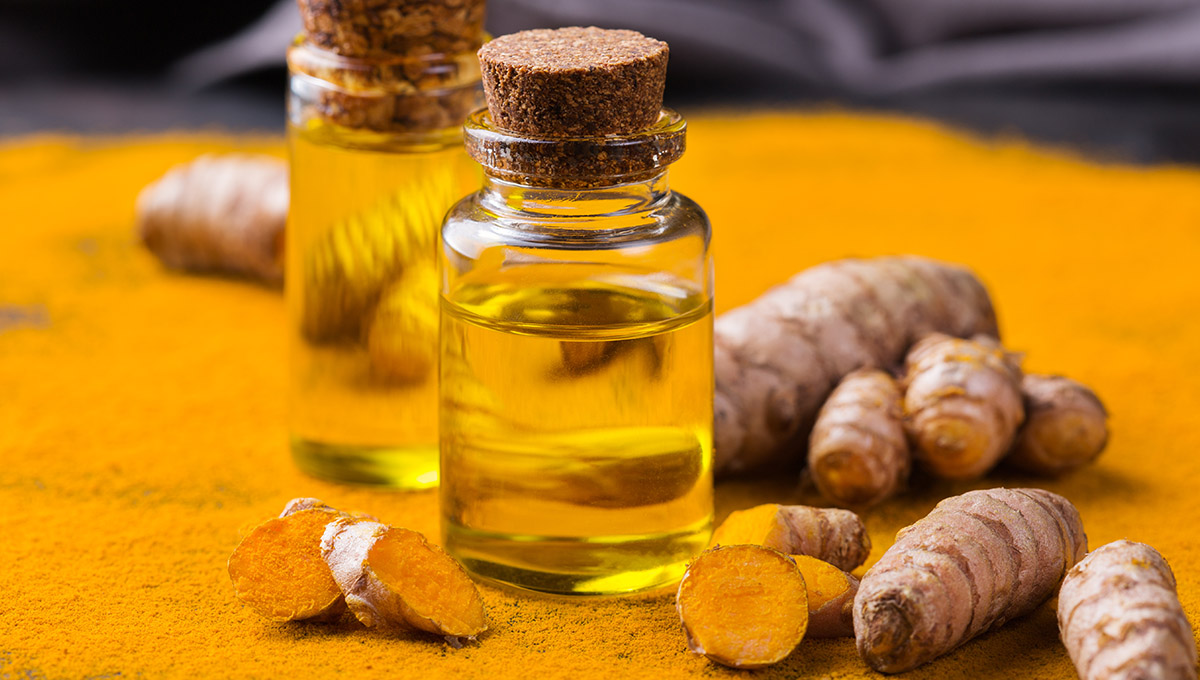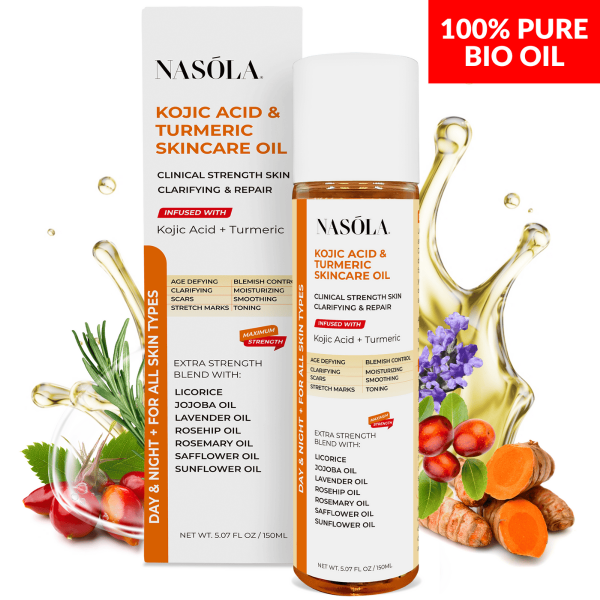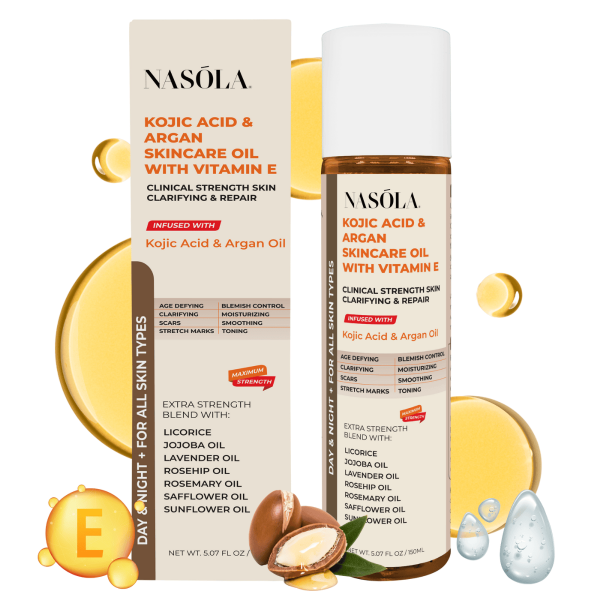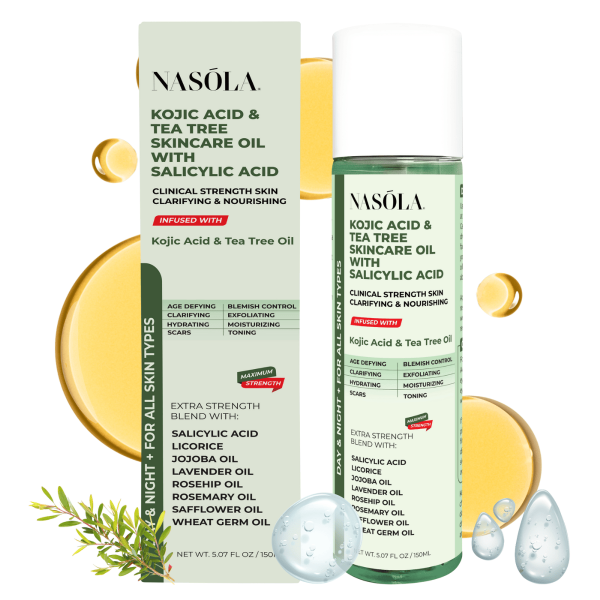Turmeric oil for dark spots? It’s officially having a moment—and trust us, it’s totally earned that spotlight.
I first stumbled upon it while searching for something—anything—that could calm down the random dark patches that showed up after my summer breakout.
You know the ones: they linger for weeks, making you feel like you’re constantly editing them out of selfies.
Let’s be honest: harsh spot correctors and synthetic fading creams? They’re hit or miss.
But turmeric oil?
It works because it doesn’t just fade dark spots—it soothes, brightens, and hydrates at once.
That’s why powerful blends like the Nasola Kojic Acid Turmeric Skincare Bio-Oil, the Nasola Kojic Acid Tea Tree Skincare Bio-Oil with Salicylic Acid, and the Nasola Kojic Acid Argan Skincare Bio-Oil are changing the game.
So today… we’re breaking down why turmeric oil works, how to apply it, and which products actually deliver that crystal-clear glow.
- Turmeric Oil for Dark Spots: Why It Works
- Turmeric Oil for Face Dark Spots: Is It Safe and Effective?
- How to Use Turmeric Oil for Dark Spots: Step-by-Step Guide
- Turmeric Oil for Hyperpigmentation of All Types
- Turmeric Oil for Dark Spots in a Full Routine
- Conclusion
- Frequently Asked Questions About Turmeric Oil for Dark Spots
Turmeric Oil for Dark Spots: Why It Works

So here’s the thing—turmeric oil isn’t just trendy. It’s backed by real science, and people dealing with stubborn hyperpigmentation are finally seeing results because of it.
The active magic inside is called curcumin. This compound isn’t just for lattes—it’s loaded with nutrients that hue skin bright and keep inflammation calm.
Turmeric oil shines because it absorbs far better than powdered forms, diving deep beneath the skin’s surface and getting to work.
The Skin Science Behind Turmeric
The whole buzz about turmeric oil for face dark spots comes down to curcumin. It’s an active compound loaded with antioxidant and anti-inflammatory properties.
This means it doesn’t just sit on your skin—it actively disrupts melanin overproduction that causes uneven skin tone.
Now, powdered turmeric has some benefits, sure. But turmeric oil? It penetrates more effectively, especially when formulated properly.
That’s why it’s featured in professional-grade skincare products rather than DIY masks that can easily stain or irritate the skin.
Here’s what makes curcumin special:
- It blocks tyrosinase activity (an enzyme responsible for melanin production).
- Reduces oxidative stress that may amplify hyperpigmentation.
- Soothes inflamed acne before it scars.
- Boosts skin resilience with regular use.
This science-backed ability to control melanin production at the root makes turmeric oil more than hype. It’s skincare that actually thinks ahead.
How Turmeric Oil Targets Dark Spots
Let’s get into it. Turmeric oil works by calming overactive pigment-producing cells.
Basically, when your skin experiences inflammation (from acne, sun exposure, or hormonal changes), the cells freak out and overproduce melanin—bam, that dark spot forms.
Turmeric oil tells those cells to chill. It reduces redness, calms inflammation, and regulates melanin without harsh chemicals.
Gentle but effective. That’s turmeric oil’s entire philosophy.
If you’re looking for something more potent, Nasola Kojic Acid Turmeric Skincare Bio-Oil takes this a step further. It pairs turmeric oil with kojic acid—a powerhouse known to suppress melanin—so they work together to fade stubborn spots twice as fast.
Benefits at a glance:
- Safe for daily use without causing peeling or burning.
- Helps skin recover from post-acne hyperpigmentation.
- Doesn’t clog pores — lightweight and breathable.
- Pairs beautifully with other ingredients like Vitamin C or niacinamide.
Turmeric Oil for Face Dark Spots: Is It Safe and Effective?
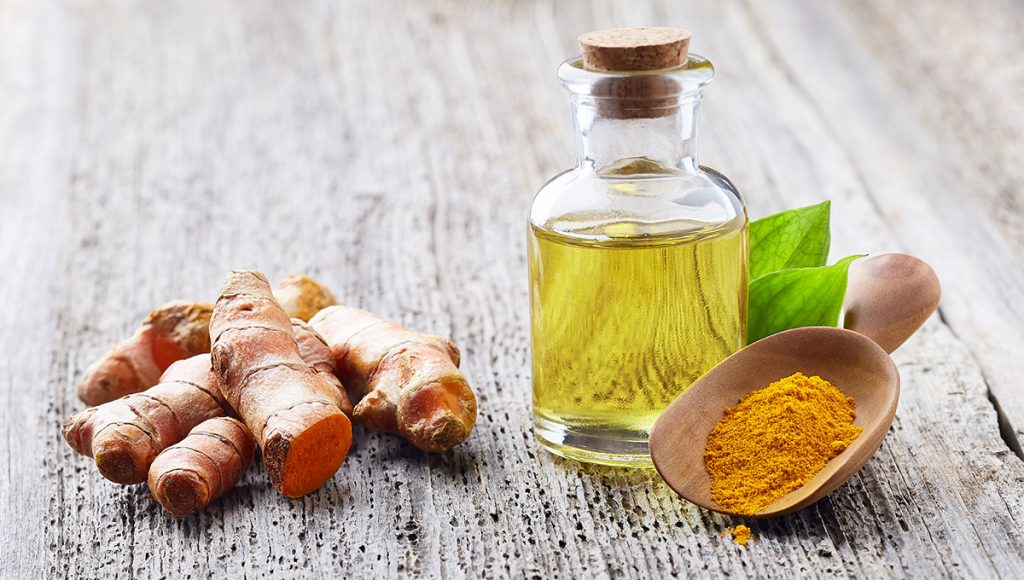
Now before you get excited and bathe in turmeric oil (don’t really please 😅), you need to know how it plays with your skin, especially facial zones.
Let’s talk compatibility and one product that seriously lives up to the hype.
Daily Use and Skin Compatibility
So, how do we know turmeric oil for face dark spots is safe? Because it’s been used traditionally for centuries — and modern science now confirms it’s effective for most skin types.
Here’s who wins with turmeric oil:
- Oily skin types: Turmeric’s antimicrobial magic helps reduce acne without clogging pores.
- Acne-prone skin: It soothes breakouts and can reduce leftover post-inflammatory marks.
- Sensitive skin: Its anti-inflammatory qualities help against redness and irritation.
- Dull skin: Restores a radiant glow thanks to its antioxidant activity.
For best results, apply 2-3 drops to clean skin once or twice daily. Consistency is 🔑.
Pro tips:
- Patch test first for sensitive skin.
- Avoid using immediately after strong actives (like peels).
- Always follow with sunscreen in AM routines.
- Hydrate well to seal in benefits.
Product Spotlight: Nasola Kojic Acid Turmeric Skincare Bio-Oil
Here’s where turmeric gets a major upgrade. The Nasola Kojic Acid Turmeric Skincare Bio-Oil is a dynamic blend of turmeric oil and kojic acid—perfect for tackling dark spots from all angles.
Why it works:
- Kojic Acid: Naturally brightens by inhibiting melanin synthesis.
- Turmeric Oil: Fades residual marks while calming inflammation.
- Bio-Oil Base: Delivers moisture without that annoying greasy feel.
It’s ideal for:
- Clearer, brighter skin tone.
- Fading acne scars & dark patches.
- Enhancing your existing skincare routine subtly but powerfully.
And it feels spa-worthy, every single time.
How to Use Turmeric Oil for Dark Spots: Step-by-Step Guide
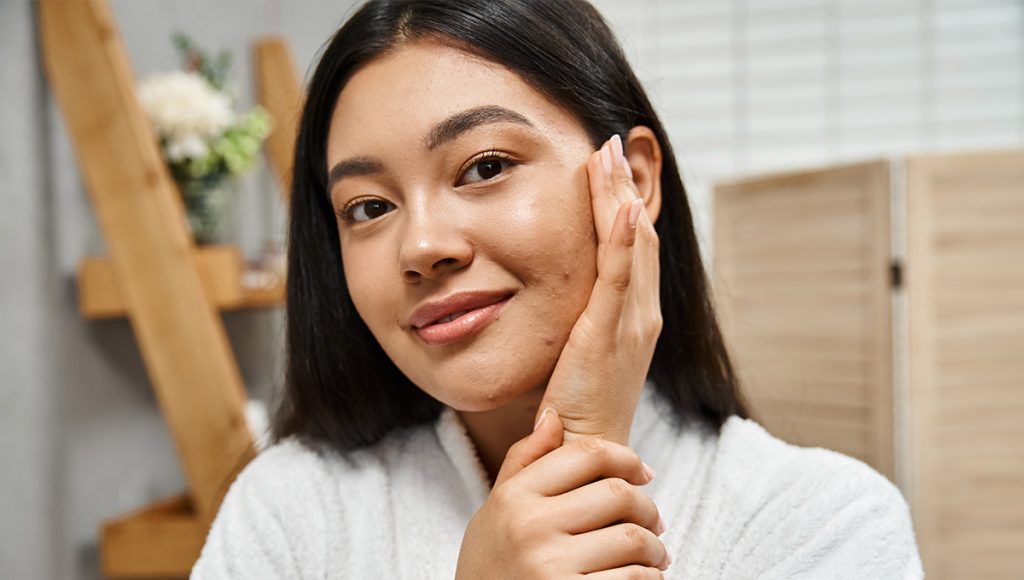
If you’re wondering how to use turmeric oil for dark spots without making a mess—or a mistake—I’m with you. I’ve been there, orange stains and all 🙃. The secret is in the method (and those ingredients on the label).
Application Techniques and Timing
Using turmeric oil properly ensures you don’t just get short-term glow—you build long-term clarity. The best approach for visible results? Targeted applications twice daily, right after cleansing.
Here’s the method:
- Cleanse your face with a gentle, pH-balanced cleanser.
- Pat dry—no wipes, no tugging.
- Apply 2–3 drops of turmeric oil with clean fingertips or a cotton ball.* Gently dab.
- Let it sink in for 2–5 minutes before adding next skincare layers.
And remember:
- Use morning + night for best results.
- Wear sunscreen (seriously) after AM use.
- Layer after actives like Vitamin C, but before moisturizer.
- Don’t overuse—less is always more.
Pairing with Complementary Ingredients
Want supercharged results? Turmeric oil pairs incredibly well with other actives that support melanin balance and skin turnover.
Power Duos to Love:
- Vitamin C + Turmeric Oil: Brightens and protects against free radical damage.
- Retinol + Turmeric Oil: Stimulates cell turnover while calming redness caused by retinol.
- Salicylic Acid + Turmeric Oil: Clears clogged pores and repairs post-acne marks.
- Niacinamide + Turmeric Oil: Reduces inflammation and boosts barrier function.
Now, one stellar recommendation if you’ve got acne-prone skin: Nasola Kojic Acid Tea Tree Skincare Bio-Oil with Salicylic Acid.
It’s got:
- Turmeric Oil to fade marks.
- Salicylic Acid to unclog pores.
- Tea Tree Oil to calm breakouts.
Perfect with minimal effort. Just apply after cleansing and let this triple threat do the rest.
Turmeric Oil for Hyperpigmentation of All Types
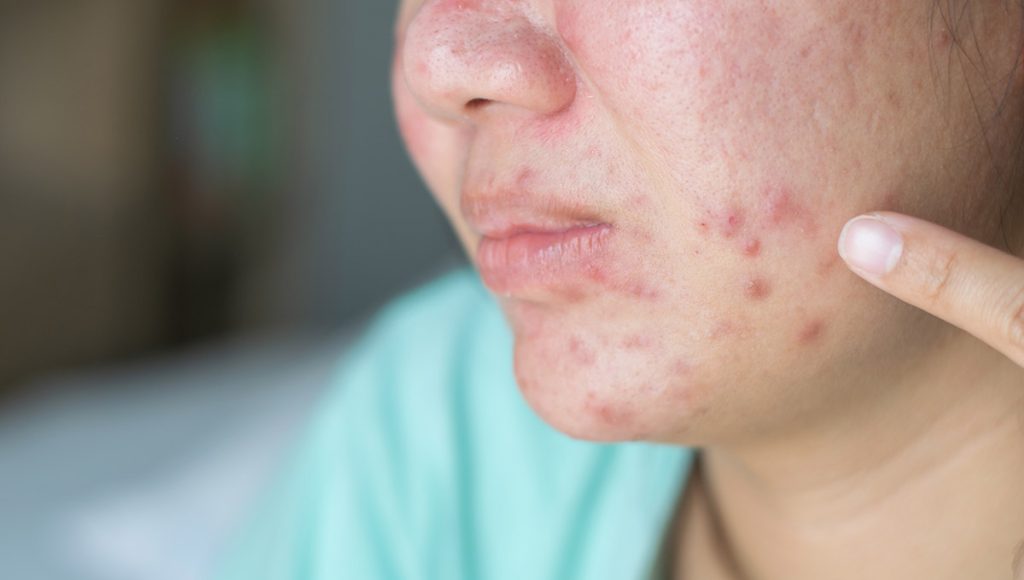
Dark spots aren’t a one-size situation. Some forms—like melasma or sunspots—cling on for dear life. Here’s how turmeric oil fares against the entire pigmentation lineup.
Melasma, Sun Spots & Post-Inflammatory Pigmentation
Turmeric oil’s secret weapon? Anti-inflammatory and melanin-stabilizing powers. It gently lightens all pigmentation types—without making your skin photosensitive like some exfoliants.
Best for:
- Melasma (hormonal pigmentation)
- Sunspots from UV damage
- Post-inflammatory hyperpigmentation (PIH)
You’ll want a formula that hydrates while it fades, especially for dry skin types.
Product Highlight: Nasola Kojic Acid Argan Skincare Bio-Oil
This is luxury therapy for skin that’s a bit more fragile, dry, or mature. Nasola Kojic Acid Argan Skincare Bio-Oil combines calming turmeric oil with nourishing argan oil.
Key perks:
- Gentle enough for sensitive skin.
- Intensely moisturizing thanks to argan seed extracts.
- Brightens hormonal or sun-induced pigmentation.
- Safe for daily, long-term use.
Apply this one at bedtime and let its velvet texture work overnight.
Turmeric Oil for Dark Spots in a Full Routine

Turmeric oil doesn’t work in isolation. It shines when slotted into a full AM/PM routine that protects your skin and feeds it the good stuff.
Integrating into AM and PM Skincare Routines
Your new (easy!) ritual:
Morning Routine:
- Gentle Cleanser
- Hydrating Toner
- Nasola Turmeric Oil blend of choice
- Broad-Spectrum SPF (always, always 🙏🏼)
Evening Routine:
- Cleanser
- Exfoliant (2–3x week only)
- Turmeric Oil
- Moisturizer
Combining with Active Ingredients Safely
Turmeric oil plays nicely with others. But there are a few ingredient pairings to avoid overdoing it.
Smart pairings:
- Vitamin E
- Niacinamide
- Ceramides
- Peptides
Be careful with:
- AHAs + Turmeric Oil (use on alternating nights).
- Enzyme masks + Oils (can cause irritation).
PRO TIP: Always patch test a new blend on your jawline first for 24 hours.
Conclusion
The verdict is clear: turmeric oil for dark spots is more than a skincare trend—it’s a transformative natural remedy that works with your skin, not against it.
Whether your concerns are acne scars, melasma, or sun damage, turmeric oil offers a gentle yet powerful solution.
Products like Nasola Kojic Acid Turmeric Bio-Oil, Nasola Tea Tree Bio-Oil, and Nasola Argan Bio-Oil combine ancient wisdom with modern skincare science.
Make the choice to glow — naturally, consistently, intentionally. 🧡
Frequently Asked Questions About Turmeric Oil for Dark Spots
Yes. Turmeric oil can help fade dark spots due to curcumin’s ability to suppress melanin production and reduce inflammation. However, pairing it with ingredients like kojic acid—as found in the Nasola Kojic Acid Turmeric Bio-Oil—can speed up the fading process.
Most users notice improvements within 4–6 weeks of consistent, twice-daily use. For stubborn spots, continued use beyond 6 weeks is ideal. Products such as Nasola’s turmeric bio-oils tend to show quicker results thanks to synergistic ingredients.
Nope! Turmeric oil is lightweight and non-comedogenic in professionally formulated products. The Nasola oils are designed to absorb fast and hydrate without clogging.
Hands-down, Nasola Kojic Acid Tea Tree Skincare Bio-Oil with Salicylic Acid. The inclusion of tea tree and salicylic acid targets acne and fades marks while preventing new breakouts.
Yes—as long as your skin handles it well, turmeric oil can be used morning and night. Just don’t forget your sunscreen if applying in the morning (that part is NON-negotiable).
Unlike raw turmeric, turmeric oil in skincare formulations like Nasola’s won’t stain. Always do a spot test, but when used appropriately, it absorbs cleanly.
Turmeric oil is a natural option and generally safe, but always check with your physician first. The Nasola Kojic Acid Argan Bio-Oil offers a gentle approach if your skin is sensitive during pregnancy.
Apply turmeric oil before moisturizer. Oils work best when applied directly to clean skin so they can absorb deeply, then seal them with a moisturizer.
Absolutely. Let it absorb fully, then apply your primer or foundation. It gives a smooth, hydrated base that makes makeup glide on effortlessly
Turmeric oil treats hyperpigmentation and inflammation simultaneously—most spot treatments only do one. Plus, when combined with ingredients like kojic acid and salicylic acid (such as in Nasola’s collections), it’s a multitasking powerhouse.

